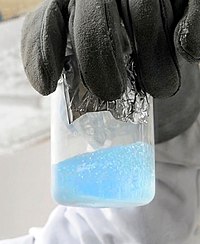
Photo from wikipedia
19F nuclear magnetic resonance (NMR) oximetry and 1H NMR velocimetry were used to noninvasively map oxygen concentrations and hydrodynamics in space and time in a model packed bed biofilm system… Click to show full abstract
19F nuclear magnetic resonance (NMR) oximetry and 1H NMR velocimetry were used to noninvasively map oxygen concentrations and hydrodynamics in space and time in a model packed bed biofilm system in the presence and absence of flow. The development of a local oxygen sink associated with a single gel bead inoculated with respiring Escherichia coli was analyzed with a phenomenological model to determine the specific growth rate of the bacteria in situ, returning a value (0.66 hr−1) that was close to that measured independently in planktonic culture (0.62 hr−1). The decay of oxygen concentration in and around the microbiologically active bead was delayed and slower in experiments conducted under continuous flow in comparison to no‐flow experiments. Concentration boundary layer thicknesses were determined and Sherwood numbers calculated to quantify external mass transfer resistance. Boundary layers were thicker in no‐flow experiments compared to experiments with flow. Whereas the oxygen concentration profile across a reactive biofilm particle was symmetric in no‐flow experiments, it was asymmetric with respect to flow direction in flow experiments with Sherwood numbers on the leading edge (Sh = 7) being larger than the trailing edge (Sh = 3.5). The magnitude of the experimental Sh was comparable to values predicted by a variety of correlations. These spatially resolved measurements of oxygen distribution in a geometrically complex model reveal in innovative detail the local coupling between microbial growth, oxygen consumption, and external mass transfer.
Journal Title: Biotechnology and Bioengineering
Year Published: 2020
Link to full text (if available)
Share on Social Media: Sign Up to like & get
recommendations!